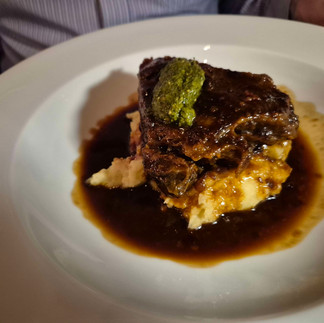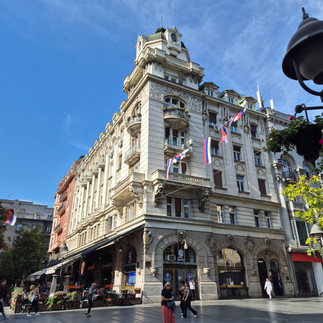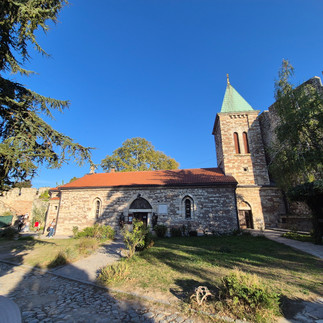Mystery tour Autumn 2024. Post 2 36 hours in Belgrade
- Anne B 10milesfrom

- Sep 25, 2024
- 5 min read
Updated: Oct 16, 2024

Our original plan for this trip was that it would be a land based adventure, using mainly trains. However, sadly, the rail network in this region has dramatically decreased over the last 10 years, so we had to take a short flight to our next destination. We were a little surprised when our plane had no markings at all!

Apparently this is a 'wet lease' plane, leased to an airline complete with crew. We were flying with Air Serbia, who have fairly low ratings, so we're slightly perturbed when they announced that it was a leased plane so service may not be up to their usual standard!!! In fact, all went well, and we even got complimentary biscuits and water!! The biggest restriction for us was an 8kg weight limit! So we really are travelling light!! Our destination... Belgrade, capital of Serbia, and once capital of Yugoslavia when the whole area was unified under Marshal Tito, widely regarded as a benevolent communist dictator. He was a respected leader who broke off links with the USSR, and kept this troubled region together by encouraging respect for each other's cultures and traditions. How quickly it fell apart after his death, leading to the terrible wars of the 1990's. So, what would Belgrade have to offer? There was certainly a more edgy feel here!
A country that seems to want to join the EU and Nato one minute, but looks east to Russia and China the next. Hard to read. We arrived in the evening to a modern airport and had a great air bnb in the city centre.

Just time for dinner in Little Bay, an opera themed restaurant just a few minutes walk away, with great Serbian style food. Which means meat! It was delicious, and the staff were very friendly.
A wonderfully quiet night and then we walked to Republic Square for a walking tour entitled 20th Century History with Belgrade free tour.

There were just 4 of us, and it was excellent. Again, Belgrade is a crossroads city that has been invaded by almost everyone. Founded by the Romans, it became a Christian city under the Slavs before being taken over by the Ottomans in 1521. Constant battles between them and the northern Austian-Hungarian Empire mean that in its history, Belgrade has been the site of 115 major battles and was virtually destroyed 44 times! The post war communist era saw many of its grand buildings stripped of their decoration, although some have now been restored.
Although church going was not forbidden, it was regarded with suspicion and would be a barrier to any job connected with Government or the state industries. The religion here is 96% Serbian Orthodox. Our guide was well travelled and works in many of the Balkan countries, but we were certainly aware, from talking to people and seeing the graffiti, that this is a country where sentiments run high and opinions are divided about whether to look east or West. Corruption is obviously a problem too. So much so that everyone seems to speak openly about it!
One striking building that remains is the Art nouveau Hotel Moskva, built as an Insurance building when Belgrade's train network linked Belgrade to London, Paris, Vienna and Istanbul via the Orient Express. It soon became a grand hotel to cater for the equally grand customers. Paris fashion houses were based here, wonderful concerts were held with the most famous international orchestras, and beautiful buildings sprang up.
However Belgrade was heavily bombed in WW2 and the resulting communist era led to more utilitarian buildings replacing them. The Government house and parliament are still very grand, and the site of the former royal residence is now a public park. There are lots of parks, many with fountains and sculptures.
We passed the old cathedral with this impressive sculpture of the previous Patriarch of the Serbian Orthodox church.

The next stop was at the television and radio station which was bombed by Nato in the war.

This building has been left as a monument to the civilians who died in the raid. It was very sad, and it is fair to say that we saw some anti Nato Graffiti in our days here! Our next destination was the Nicolas Tesla Museum. He was born and studied in Serbia, so this museum was created, and some of his original equiment is here, plus his ashes, in a golden sphere because he believed they were the perfect shape. He is seen as Serbia's greatest son (along with Novak Djokovich!), and has been increasingly recognised for his creation of AC electrical supply systems, now used in electric cars, and his contribution to wireless technology.
Admission is by tour only, on the hour, and they fill up fast! You start with a film about his life and then demonstrations of his electrical equipment. Lightning was created, and the radiating ions were enough to light up neon light tubes in our hands. That was impressive!
Next we walked to the Cathedral of St Sava.... this time a new church! Well, relatively new!

The foundations were laid in 1935, but wars and communism meant building only really got going in the 2000s, and it isn't quite finished! It is both enormous, and exquisitely decorated. The mosaics in the domes cover 15,000 square metres!

Our lunch cost under 50p each, and was a selection of tasty pastries from a local bakers. Cream cheese and olives, local sausage and pancetta and cheese!

I haven't mentioned the weather... glorious sunshine and 28°C! We had a lot of walking left to do! We retraced our steps and as we passed the Hotel Moskva decided to have drinks and a slice of their famous Moskva cake...layers of sponge and cream with pineapple and cherries. Delicious!
Now a long walk through the smart town centre to the vast fortress which occupies the huge promontory where the River Sava joins the Danube. This is where the Romans built their first castle of local white limestone, and Beograd (Belgrade) means White city. We stumbled on a rather small Balkan food fair whose main features were the remnants of a wild boar spit roast and the very traditional Jack Daniels and coca cola van!
Walking around the ramparts was lovely, and our final destination was Ruzica church. Renovated in 1925 it has some rather unique chandeliers made from ammunition- shell cases and other weapons. Every church here seems to contain relics of saints, usually in the former of a finger, or a piece of bone, and they are highly revered. This church had a box full!
A walk back through the fort to the riverside where we had a great supper at Ambar watching the sunset over the river. A final walk back to our Air bnb made our walking miles 7.52. And Belfrade is hilly!
The next morning saw us returning to the airport for a short flight out of Serbia to our next destination. We were very glad we came here as it has helped us understand what this area has been through over the years, and why sentiments run high, especially about disputed areas like Kosovo.
P.S Down at the riverside, this runner stopped to catch his breath. I don't think he realised he was mirroring the statue further along the Quay! It made me smile!




































































Did anyone mention how Serbs brought out the straw that broke the Yugoslavian camel’s back? Just like Russians they have a superiority complex and like strongmen. Did you know Tito was not Serbian buy half Slovenian and hlaf Croatian. That’s why he promoted the idea of respect for all nations, languages and cultures. and brotherhood and unity through diversity. Something Serbians quickly abandoned after he died.